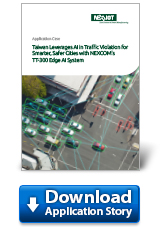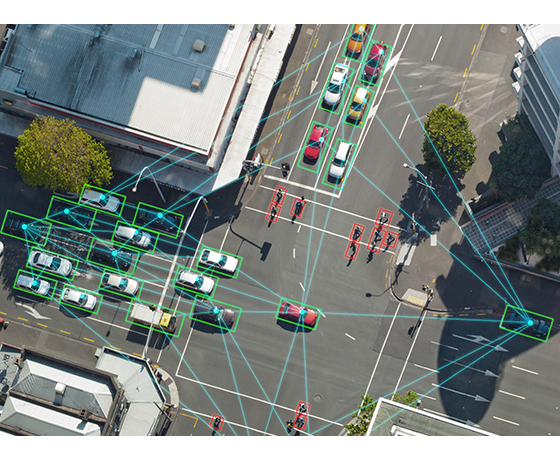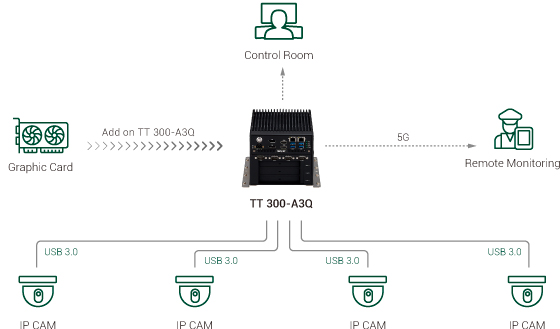Taiwan Leverages AI in Traffic Violation for Smarter, Safer Cities with NEXCOM's TT-300 Edge AI System

Background
Taiwan, a densely populated island nation, faces unique challenges in managing its traffic systems. According to the statistics report by the Ministry of Transportation and Communications, the country boasts a staggering 23 million vehicles, nearly one per person. This high vehicle density translates to a constant presence of cars and motorcycles on the streets, leading to potential safety concerns at intersections, such as: Red light violations. Illegal parking. Disregard for pedestrian safety. These challenges necessitate effective strategies to ensure the safety of all road users in Taiwan.

Challenge
While Taiwan has previously utilized traffic intersection cameras for law enforcement, these systems faced certain limitations:
- Low camera resolution: This led to poor image quality, particularly in low-light conditions, such as rainy days or nighttime, hindering accurate identification of violations
- Ineffective file compression: This resulted in increased file sizes, placing significant strain on processing power and impacting overall efficiency.
- Limited camera angles and rigidity in judgment standards: CAMShift (Continuously Adaptive Mean Shift), a color-based object detection algorithm, is commonly used in for issuing traffic violations, However, CAMShift has some limitations. One of the major drawbacks of the standard variant is that it cannot track the desired target when the background (or an object nearby) is of the same color. These factors led to inconsistency in capturing violations and potentially unfair judgments, prompting public complaints and requiring resource-intensive manual reviews.
These limitations highlight the need for innovative solutions to improve traffic surveillance capabilities in Taiwan.
Solution

Solution Architecture
TNEXCOM’s TT 300-A3Q are installed in the traffic signal box in major crossroads in Taipei and Taichung City. Comparing to other high performance products, the NEXCOM TT 300-A3Q‘s compact size could seamlessly integrate into the limited space, demonstrating its remarkable performance even in the challenging conditions of high temperatures and humidity. The device operates efficiently within a wide temperature spectrum of -5°C to 55°C and a humidity range of 10% to 95%. With all I/Os at front, it is designed for easy maintenance and installation.
The police officer uses TT 300-A3Q’s to connects CCTV cameras to record data and perform plate recognition to catch traffic violators who pass speed limit, cross red line, block pedestrian and parking violation.
Powered by an Intel® 12th or 13th Gen Core™ processor, the TT 300-A3Q delivers maximum graphics processing power and supports connections to various storage devices, peripherals, and internal components. This empowers it to effectively handle industrial AI applications, encompassing tasks like image processing and optimization, machine learning, deep learning, and machine visionAI algorithms can analyze video footage and sensor data with high accuracy and high speed, reducing the chances of human error in identifying violations. This can lead to fairer enforcement and fewer wrongful citations.
With higher resolution cameras, transmitting the increased data requires higher bandwidth and more stable interfaces like 5G and USB3.2 Gen2, which are supported by the TT 300-A3Q.
Benefits and Results
In the future, City Government will expand the TT-300-A3Q edge AI computing system to other intersection. The main benefits are as below.
1. Enhance Law Enforcement Accuracy: In the past, traffic intersection violation identification was done by taking pictures with cameras in traditional way, such as CamShift algorithm. However, it has some limitations in tracking the desired target with the background of the same color. This would lead to misjudgments or repeated manual judgments. By implementing the NEXCOM TT 300-A3Q edge AI computing system, video footage and sensor data analysis can achieve high accuracy and speed, significantly reducing the likelihood of human error in identifying violations. Besides, it can also reduce labor costs and increase work efficiency in police office.
2. Optimize Traffic Flow: NEXCOM TT 300-A3Q edge AI Computing system can analyze real-time traffic data from various sources to optimize traffic flow. It can control traffic signals in real-time, adjusting signal timings based on actual traffic flow. This leads to reduced congestion, shorter travel times, and decreased fuel consumption. It also can suggest alternate routes in real-time, considering current traffic conditions. This minimizes delays and helps drivers avoid unexpected obstacles.
- Related Links:
- Revolutionizing Health Monitoring: A Self-service Health Check Kiosk Success Story with NDiS B338
- AI and Advanced Tech Revolutionize Drive-Thru and Delivery for QSRs
- Browse Other News:
- AI Emerges as a Game-Changer in Disaster Management: From Reactive to Proactive
- Revolutionizing Health Monitoring: A Self-service Health Check Kiosk Success Story with NDiS B338
- All Case Study News

